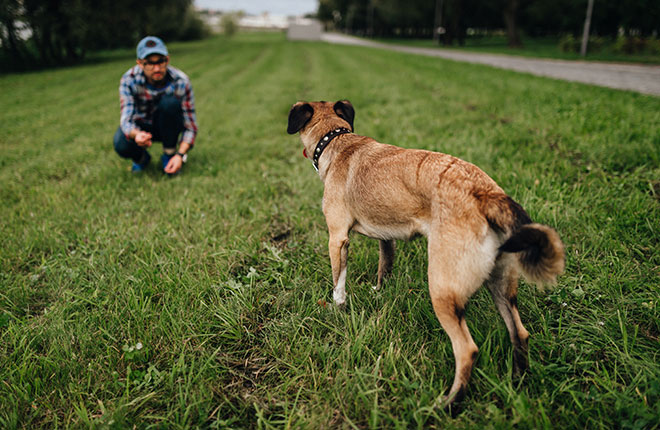Being able to allow your dog off-leash time to run and play is a great feeling. There’s nothing like watching a dog frolic and freely explore on their own, the utter joy they exude when they find a new smell, and the trust you have that they will come back when called. But wait — will they come back when you call?
It’s all about making your dog more motivated to come to you instead of going on other adventures, like checking out the neighbor’s trash or going to visit the dog across the park. It has to be worth it for your dog to choose to come to you over chasing that squirrel.
Teaching your dog to come when called (which we’ll refer to as “recall” throughout the article) is imperative to ensuring safety for your dog, other dogs, people, and wildlife.

You shouldn’t allow your dog off leash if you aren’t completely sure that they will come back when called. This behavior can be tough for many dogs, especially around real-life distractions. Before letting your dog off their leash, work on building a strong foundation for your dog’s recall by focusing on attention and motivation.
Attention
If your dog isn’t paying attention to you in the first place, they most likely won’t even hear you when you call them to come, especially if you are further away or if there are lots of distractions. Teaching your dog to pay attention to their name or a “Look at Me” cue is a great foundational step for training.
Motivation
Your dog should want to come to you! You can build motivation by associating the action of coming to you with fantastic things. The reward for coming when called doesn’t always need to be food treats. In fact, you’ll get a more reliable recall if you vary the rewards your dog receives. Food treats are highly motivating, but many dogs find playing a game, getting to go outside for a walk, or praise and petting very rewarding as well. Let your dog tell you what they find rewarding at the moment and use that to your advantage.
Coming to You Should Always Be Fun
The flip side of building motivation is making sure you aren’t teaching your dog that coming to you ever ends in something negative or unpleasant. This could be anything from losing possession of an item (like the Kleenex they just dug out of the trash), being put in their crate before you leave for work, being given a bath, or being scolded for not coming soon enough.
If this happens, they’ll think that coming to you is something unpleasant and they’ll think twice about coming to you next time you call them.
Practice Using Everyday Activities
Think about moments in your regular routine when your dog already comes consistently. Calling them for breakfast or dinner helps build a powerful positive association with the cue. If your dog loves to play in the yard, call them to come and reward with opening the door to go outside. Randomly call them to come and reward with belly rubs or a game of tug. Your dog will learn with consistency and repetition that when they hear “come” it’s always worth it to come running.
Get these everyday situations down before moving your practice to a distraction-filled place and go slow when adding distractions. Practice in a fully-fenced yard or use a long lead to keep your dog safely leashed while practicing outdoors at further distances.
For your dog’s safety, do not allow your dog off a leash in an unfenced area until you have successfully practiced their recall and are confident they will come when called. By taking the time to build a foundation of motivated recall, you’ll avoid being that person who is chasing after their dog at the park, begging for them to come back. You’ll have peace of mind knowing that you can reliably protect your dog while they are off leash, calling them away from potentially dangerous situations, from wildlife encounters to busy streets.
ZPC-00197R1



